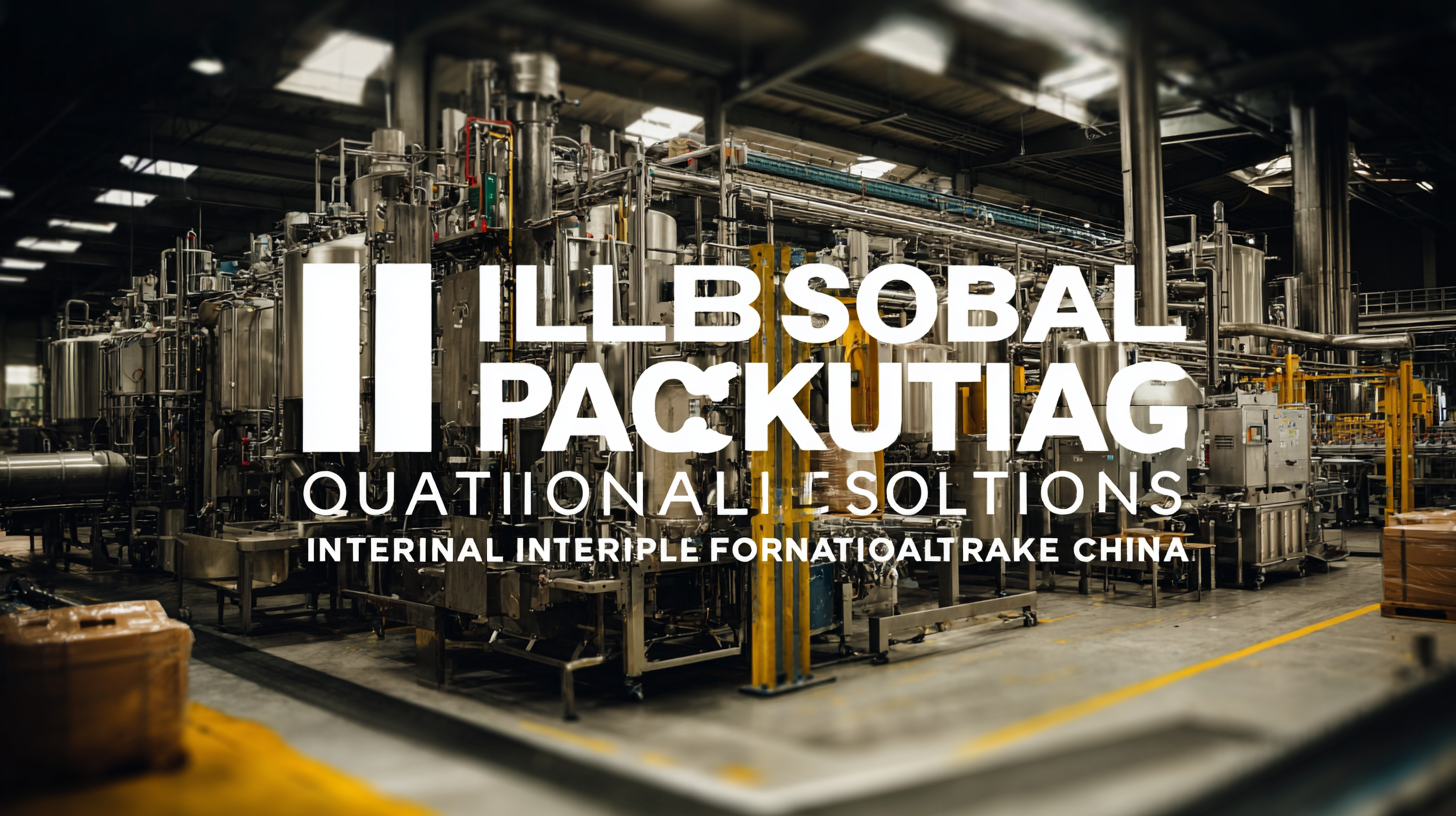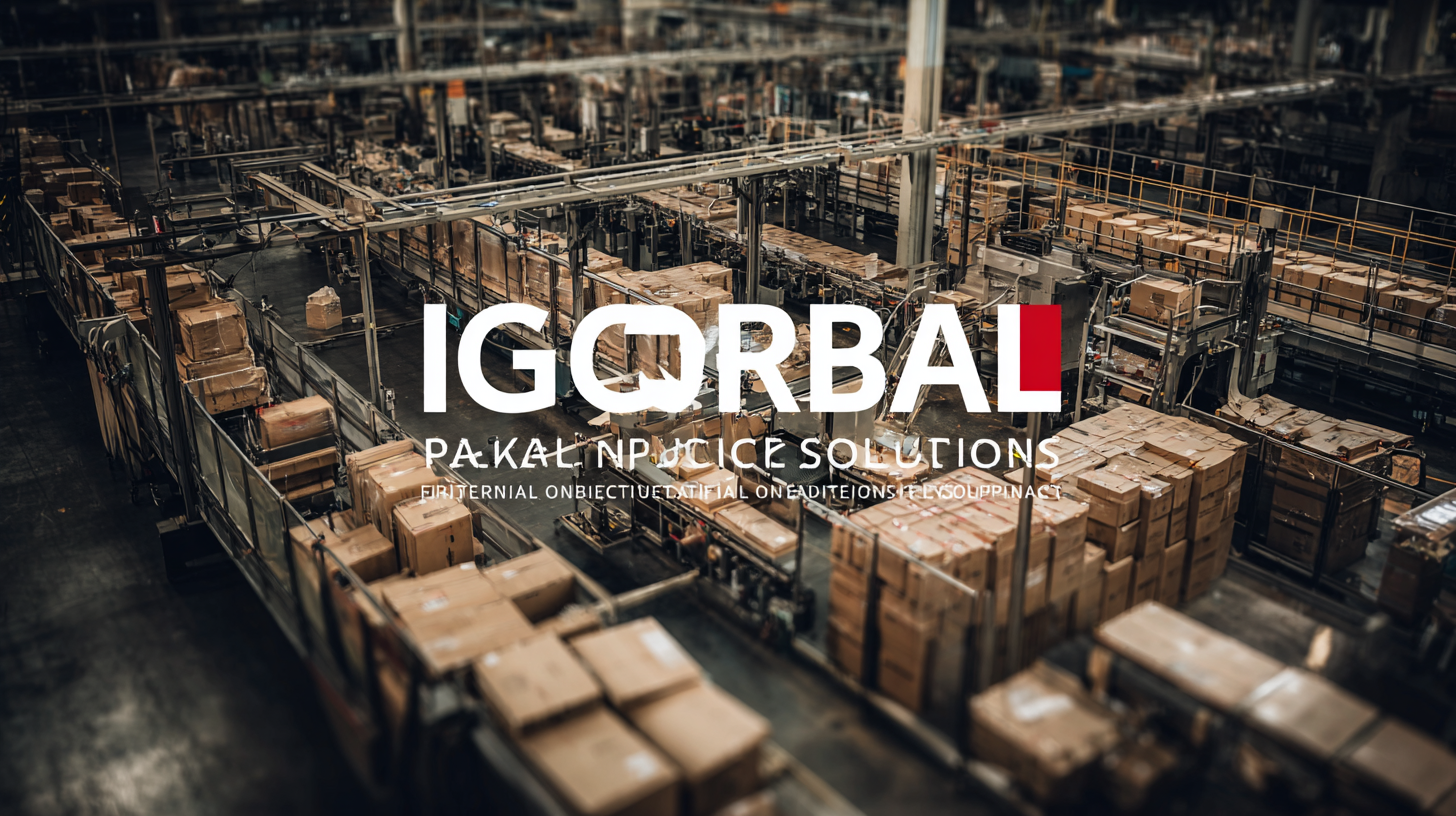A-B-C Blog
Global Quality Packaging Solutions Empowering International Trade from China
In an era where global trade continues to expand, the importance of efficient and reliable Industrial Packaging Equipment cannot be overstated. According to a report by Smithers Pira, the global market for industrial packaging is projected to reach $650 billion by 2024, driven by the increasing demand for packaging solutions that enhance product safety and sustainability. As international trade from China flourishes, companies are seeking innovative packaging solutions that not only protect their goods but also streamline logistics and reduce costs. The integration of digital technologies into packaging processes is revolutionizing how goods are prepared for shipment, providing businesses with the competitive edge needed to thrive in a dynamic marketplace. As brands strive to meet consumer expectations and regulatory requirements, the role of advanced industrial packaging solutions becomes paramount, ensuring that products reach their destinations in optimal condition while supporting the growth of global trade.

Challenges in Adapting Global Packaging Standards in China's Export Industry
Navigating the complexities of international trade, China's export industry faces significant challenges in adapting to global packaging standards. According to a report by Smithers Pira, the global packaging market is projected to reach $1.05 trillion by 2024, emphasizing the importance of compliance with international packaging regulations. However, many Chinese manufacturers struggle with these standards due to varying regulations across different countries, which can lead to delays and increased costs.

To effectively address these challenges, exporters must prioritize understanding regional packaging requirements, especially concerning materials and labeling. For instance, adopting sustainable packaging practices not only meets the standards set by many countries but also appeals to environmentally-conscious consumers. Utilizing materials that comply with recycling and biodegradable guidelines can enhance product acceptance in foreign markets.
Tip: Regularly updating your knowledge about international packaging regulations can save time and resources. Consider investing in training programs focused on global compliance to ensure your team is well-equipped to meet these challenges.
Another critical consideration is the impact of e-commerce on packaging strategies. The rise of online shopping has led to increased demand for efficient and protective packaging solutions. As per Statista, e-commerce sales are expected to surpass $6 trillion globally by 2024, making it essential for Chinese exporters to adopt adaptable packaging that meets the expectations of both consumers and regulatory bodies.
Tip: Collaborate with packaging design experts to create solutions that not only protect goods during transit but also enhance brand presentation and consumer experience.
Impact of Packaging Quality on International Shipping Costs: A Data-Driven Analysis
In an increasingly interconnected world, the quality of packaging plays a pivotal role in the efficiency and cost-effectiveness of international shipping. When products are packaged adequately, it not only safeguards the integrity of the items but also minimizes the risk of damage during transit. This directly correlates with reduced shipping costs, as damaged goods can lead to expensive returns and replacements. By adopting advancements from Packaging 4.0, businesses can ensure that their products are customized for their destination, thus optimizing the logistics chain.
Tips for improving packaging quality include investing in data validation techniques to ensure that specifications are met consistently. Reliable data can inform better design decisions and materials selection, enhancing both protection and presentation. Additionally, companies should conduct regular assessments of packaging materials to identify opportunities for sustainability. Utilizing eco-friendly materials not only appeals to environmentally conscious consumers but can also reduce shipping weights, leading to further cost savings.
Moreover, as the global packaging market evolves, integrating technology into packaging solutions offers a competitive advantage. Smart packaging technologies can provide real-time tracking and inventory management, which helps in maintaining optimal stock levels and reducing overhead costs. By focusing on these areas, businesses can position themselves favorably in the dynamic landscape of international trade.

Sustainability in Global Trade: Packaging Innovations from China
In today's interconnected world, sustainability has become a key driver in international trade, and China is at the forefront of this transformative movement. The rise of eco-friendly packaging innovations reflects a growing commitment to minimizing environmental impact while enhancing the efficiency of global supply chains. From biodegradable materials to reusable packaging solutions, Chinese companies are pioneering practices that align with the principles of sustainable development.
One noteworthy advancement is the introduction of smart packaging technologies that not only reduce waste but also improve product traceability. These innovations utilize advanced materials and IoT connectivity, allowing for real-time monitoring of goods during transit. This not only ensures the integrity of products but also fosters transparency in the supply chain, addressing consumer demand for ethical sourcing and sustainability. By integrating eco-conscious practices, companies are not only meeting regulatory requirements but also enhancing their competitive edge in the global market.
Moreover, the shift towards sustainable packaging is complemented by China's dedication to reducing carbon emissions and promoting the circular economy. Initiatives such as recycling programs and partnerships with local governments aim to create a robust infrastructure for sustainable logistics. As businesses embrace these packaging innovations, the goal of achieving a greener, more sustainable future in international trade becomes increasingly attainable.
Navigating Compliance Issues in International Packaging Regulations
In the realm of international trade, navigating compliance issues in packaging regulations is crucial for businesses looking to expand from China. Each country has distinct packaging laws that govern materials, labeling, and safety standards—failing to comply can lead to shipment delays, financial penalties, and reputational damage. Companies must stay updated on both local and international regulations to ensure that their products not only meet the requirements of their target markets but also adhere to sustainable practices.
**Tip 1:** Invest in training programs for your team to stay informed about evolving packaging regulations. This proactive approach can help mitigate the risks of non-compliance.
Packaging solutions should also prioritize clear and accurate labeling. Misleading or inadequate information can result in customs rejections and increased scrutiny. It’s essential that all packaging materials are easily comprehensible to both consumers and regulatory bodies, fostering transparency and trust.
**Tip 2:** Utilize professional packaging consultants who specialize in international trade. They can provide insights into specific regulations and assist with proper documentation to ensure smooth transactions across borders.
Global Quality Packaging Solutions Empowering International Trade from China - Navigating Compliance Issues in International Packaging Regulations
| Country/Region | Regulation Type | Description | Compliance Status | Notes |
|---|---|---|---|---|
| USA | FDA Regulations | Food safety and labeling requirements for packaging | Compliant | Regular audits required |
| EU | REACH | Registration, Evaluation, Authorization, and Restriction of Chemicals | Compliant | Continuous monitoring required |
| Australia | Australian Packaging Covenant | Promotes sustainable packaging and waste reduction | Compliant | Annual reporting required |
| Canada | Consumer Product Safety Act | Safety standards for packaging materials | Non-compliant | Revision of materials needed |
| Japan | Container and Packaging Recycling Law | Regulations for recycling and waste management | Compliant | Regular updates on recycling technology |
The Role of Advanced Technology in Enhancing Packaging Solutions for Exporters
In today's competitive global marketplace, the demand for high-quality packaging solutions has soared, driven by the complexities of international trade. Advanced technology plays a pivotal role in enhancing these packaging solutions, ensuring that products from China meet the strict requirements of diverse global markets. Automation and smart packaging technologies, such as IoT-enabled devices, not only improve efficiency but also enhance the safety and integrity of goods during transit. These innovations allow exporters to monitor their shipments in real-time, providing assurance to both sellers and consumers.
Moreover, the integration of sustainable materials and smart designs is transforming the packaging landscape. Technologies that support eco-friendly practices are gaining traction, as many exporters are now focused on reducing their carbon footprint and appealing to environmentally conscious consumers. By adopting advanced packaging solutions that utilize biodegradable or recyclable materials, Chinese exporters can enhance their brand reputation internationally, making a positive impact on both the market and the environment. As technology continues to evolve, so too will the capabilities of packaging solutions, empowering exporters to navigate the challenges of international trade with confidence.






